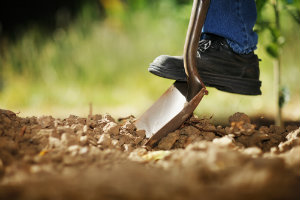While it can be easy to get overwhelmed with the pre-winter blahs when the days get shorter and the weather becomes less pleasant, it is good to keep in mind that the better you prepare your garden now, the easier it will be to enjoy that space in the spring. Particularly when you live in an area, like Alberta, that has a long winter, the springtime awakening of plants in your yard can help work as a great pick-me-up.
Yard Clean Up

Before the weather gets too stormy or snowy, it’s a good idea to make sure that you clean up your yard to avoid yard debris from blowing around or becoming dangerous. Fallen leaves should be removed from the lawn to avoid smothering the grass or mouldering; as leaves decompose they often become slippery and treacherous.
Another important area of clean up—particularly if your area gets wind storms or heavy snows—is pruning your trees and/or wrapping your shrubs. Heavy snows or winds can break off branches or compress trees in ways that can disfigure or kill them. Consult a tree expert if you are unsure how to properly prune your trees.
Plant Bulbs
One of the nicest parts of spring is when the bulbs that you planted in the fall come up. There are lots of great options for flowers that grow from bulbs, and one of the best things about them is that you can put them in the ground and kind of just forget about them. Mid-September is generally the best time to plant bulbs in your yard in this area, so it is a bit late for this year, but you can also plant bulbs in pots and then let them winter in your garage.
A great thing about planting bulbs is that you can really put them anywhere. While flowers like tulips are probably best used in flower beds, crocuses and snowdrops can be planted around the base of trees in the lawn.
Get a Head Start on Vegetables
While many people think of spring as the only crop planting time, there are some crops that you can plant in the fall too! If you have an area that is relatively protected and bright, you can plant certain seeds that will winter just fine and provide you with fresh vegetables in the early spring. Some good choices are: kale, spinach, beets, radishes, and a variety of leafy greens. Generally, you’ll want to plant your seeds and cover the beds with mulch or burlap to protect them. Don’t water the garden when you plant it, so the seeds don’t freeze. When the spring thaw comes, remove your mulch or burlap and let your garden grow!
Posted by Chris Proctor on

Leave A Comment